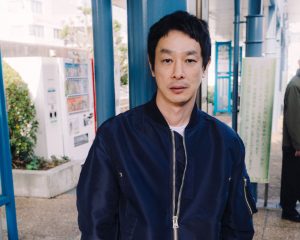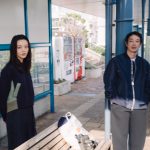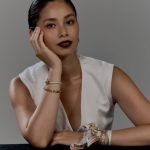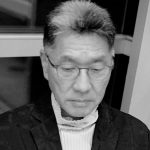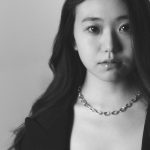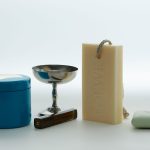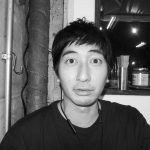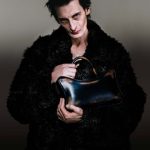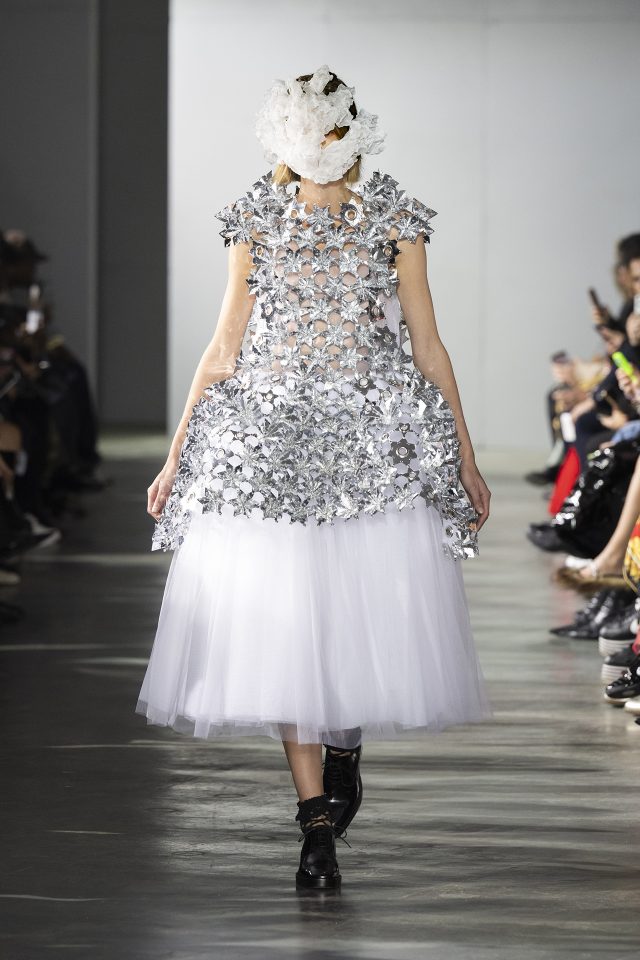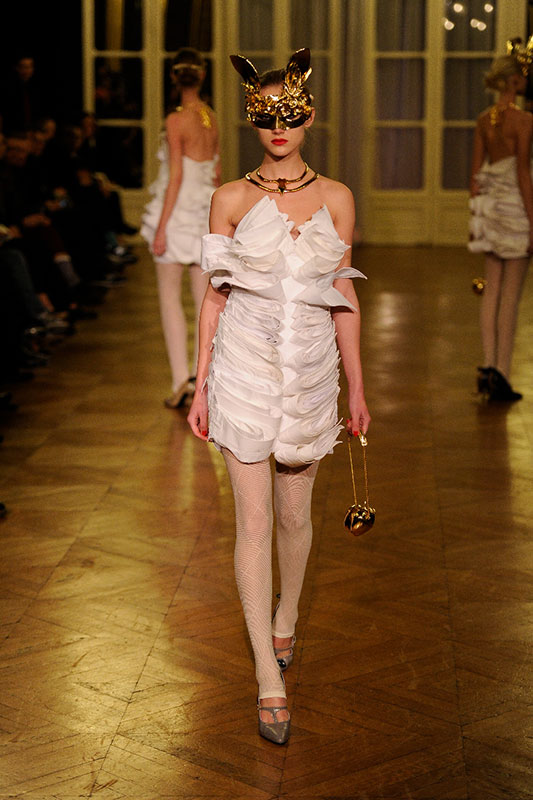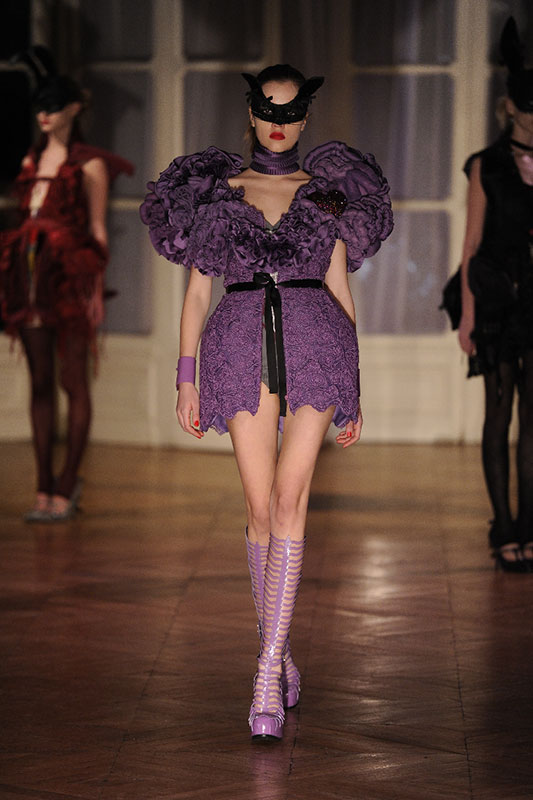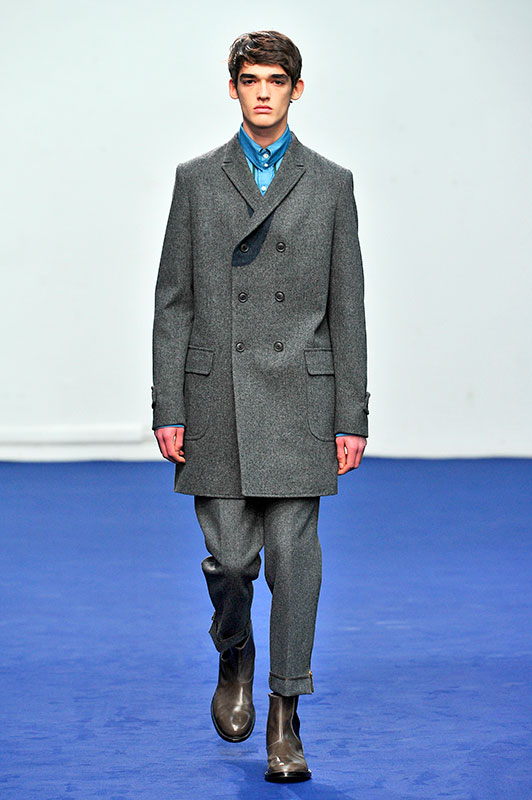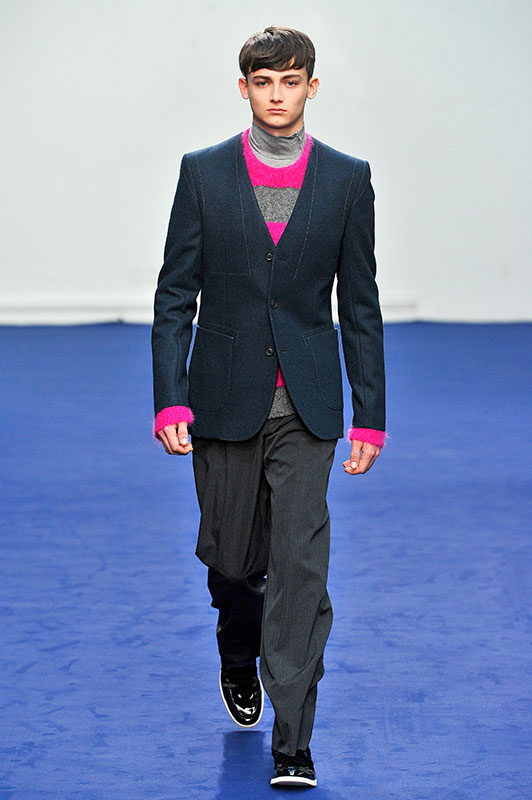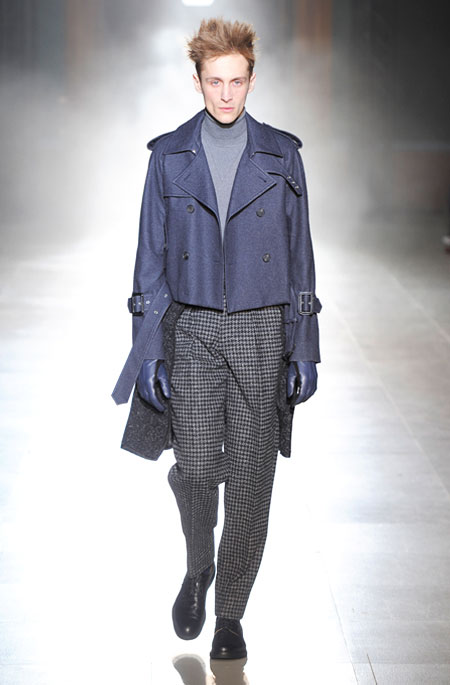ファッションコーディネーター・大塚博美インタビュー
Hiromi Otsuka
パリを拠点にランウェイ、展示会、ロケ撮影をサポートするファッション・コーディネーターとして活躍している大塚博美氏。UNDERCOVER (アンダーカバー) 、JOHN LAWRENCE SULLIVAN (ジョン ローレンス サリバン)、kolor (カラー) といった名だたる東京ブランドのパリ進出成功の裏には、この人の功労があると言っても過言ではないだろう。パリと東京、2都市のファッション業界をパラレルな視点で捉え、双方を結ぶ経路を明確に形づくる大塚氏に、その仕事内容やパリでデザイナーが成功するための条件などについてお話をうかがった。
ファッションコーディネーター・大塚博美インタビュー
Portraits
*You’ll find the English text after the Japanese.

Photo by Yoshiyuki Okuyama
パリを拠点にランウェイ、展示会、ロケ撮影をサポートするファッション・コーディネーターとして活躍している大塚博美氏。UNDERCOVER (アンダーカバー) 、JOHN LAWRENCE SULLIVAN (ジョン ローレンス サリバン)、kolor (カラー) といった名だたる東京ブランドのパリ進出成功の裏には、この人の功労があると言っても過言ではないだろう。パリと東京、2都市のファッション業界をパラレルな視点で捉え、双方を結ぶ経路を明確に形づくる大塚氏に、その仕事内容やパリでデザイナーが成功するための条件などについてお話をうかがった。
—まず、パリでファッションのお仕事を始められたキッカケは何だったのでしょうか。
もともとフランス映画や音楽が好きだったのですが、初めて旅行に行ったとき、サクレクール寺院に登って目の前に拡がるパリの夜景を見ながら「いつかここに住むだろう」という気がしました。当時は地元・熊本でロンドンから送られてくるヴィンテージや旬なストリートブランドを扱う小さなショップを営んでいましたが、ある日知り合いがパリの現地バイヤーを探しているという話を聞いて、自ら志願して行くことに。渡仏当初は洋服とアクセサリーのバイイングをしていました。
—その後、ファッション撮影やショーのコーディネーターとしてご活躍されていますが、その経緯をお聞かせください。
ファッション撮影に関わる契機となったのは、スタイリスト、ソニア・パークさんとの出会い。最初は撮影の際にアイロン掛けをするアシスタントを探してくれと頼まれたのですがアイロンくらいなら私でも掛けられるよ、と生まれて初めての撮影に参加することに。パリの可愛い場所などを提案するうちにソニア・パークさんと意気投合して、次の撮影時にはコーディネーターになっていました。なので、コーディネーターとして研修をした経験はないんです。また、初めてファッションショーのコーディネートを担当したのは、90年代初頭の YOHIKI HISHINUMA (ヨシキ ヒシヌマ) のコレクション。この時は COMME des GARÇONS (コムデギャルソン) などのショーを手掛ける演出家の若槻善雄さんからお話がきました。ショーのコーディネートは、セールスエージェントやプレスオフィスを見つけることから、会場やモデル・キャスティングの手配、またスタッフのホテルのブッキングまでと多岐に渡ります。当時は人脈も経験も無かったのですが、なんとなく「やれるかも知れない」と思って引き受けました。
—ファッションショーの初仕事から現在に至るまで、コーディネートを手掛けたブランドは?
YOHIKI HISHINUMA の約2年後にアバハウスの 0918、および 5351POUR LES FEMMES (5351プーラ・ファム) のショーを手掛けました。レディース2ブランドを掛け持ちすることになって、忙しい時期でした。そして2003年春夏コレクションに UNDERCOVER のパリ・デビューとなるショーを担当。以後、UNDERCOVER のコーディネートは継続して行っています。その後は2004 -05年秋冬コレクションから NUMBER (N)INE (ナンバーナイン) のショー、2008年春夏コレクションから MISTER HOLLYWOOD (ミスター ハリウッド) の展示会、あいだに DRESSCAMP (ドレスキャンプ) のプレゼンテーションを挟んで、2012-13年秋冬コレクションからJOHN LAWRENCE SULLIVAN (ジョン ローレンス サリバン)、kolor (カラー) のショーを手掛けています。
—そうそうたるラインナップですね。日本のブランドが、パリで成功するために必要なことは何だとお考えでしょうか。
「このブランドはこうなんだ」という明確な‘個性’です。海外のバイヤーに評価されるには、ハンガーラックにかかっている服を見ればそのブランドだと認識できるようなオリジナリティが大切。kolor を例に喩えると、独特のシルエットや色の組み合せ、裏地などのディテールへのこだわりに強いオリジナリティがうかがえます。 ‘個性’があるということは即ち、デザイナーが自分の好きなもの、作りたいものを作っている、ということではないでしょうか。

—現在パリを拠点に、パリと東京を年4~5回のペースで行き来されているそうですね。二都市のコレクションの違いはどんな点にあるのでしょうか?
パリのレディスのファッションウィークは約10日間に渡る凝縮された日程が組まれていて、期間中にショーを行い、そのまま展示会をやって、「見たら熱いうちに買わせる」「来たお客さんを逃さない」というシステムになっています。一方、東京の場合はショーと展示会の期間が離れるため、コレクション中に海外からバイヤーが訪れても、まだ展示会をやっていないから買えない、というのが実情。折角デザイナーが頑張っていて、いいショーもたくさんあるのに、海外との取引が成立しにくい状況です。ショーの1,2日後にはバイヤーが実際に商品を手に取って見られる、オーダーできる、という連結したスケジュールにすべきではと思います。
—ルックブックによるオーダーではなく、 バイヤーが商品を手に取ることが大切なんですね。
日本の服はディテールまで凝って作られていて、かつ仕立てが綺麗なものが多い。実際手に取ってみせることによって「こんなところまで細工が行き届いている」と、服好きの人を喜ばせ魅了する力があります。海外で販売する際には価格帯的に高級ブランドと並ぶゾーンになりますが、それでも日本のブランドのクオリティは十分競争力があります。
—閉鎖的と言われがちな東京コレクションですが、ブランドのパリ進出についてどのようにお考えでしょうか。
東コレを盛り上げていくことも大事ですが、進出してみたい人はトライすべきです。パリコレに集まるジャーナリストやバイヤーはお世辞を言わない。日本では耳にしないようなストレートな本音が聞けます。またヨーロッパのバイヤーは、1シーズン目には買いません。日本の場合はセレクトショップが多いのでエクスクルーシビティを取るために1シーズン目から飛びつかざるを得ないところもありますが、ヨーロッパでは1~3シーズンは様子を見てデザイナーが成長するかどうかを見極めてから買う。日本から来たら初めはがっかりするかも知れないですね。でも、値段なり、サイズなり、1シーズン目で勉強したことを反映させて、コレクションが良い方向に変わっていくと買ってくれるし、一度買うとその後忠実に関係を続けてくれます。UNDERCOVER (アンダーカバー) もパリで展示会をしない時期があったんですけど、その時も L’ECLAIREUR (レクレルール) は絵型だけでオーダーしてくれました。大好きなブランドだから、と応援してくれた。デザイナーを育てる意識を持った、本当の意味でのバイヤーがいるんです。

Photo by Yoshiyuki Okuyama
—パリ進出のやり方に関して、どのような方法がありますか。
合同展示会に出す、ショールームと契約するなどいろいろなやり方があるので、自分に合ったサイズで少しずつ展開すればいいのではないでしょうか。ただし、プレゼンテーションを行うだけでセールスを疎かにするのは NG。ファッションをビジネスとして捉えて、「見せたら売る」という形で完結しないと意味がありません。
—フランスにおける値付けのシステムや掛け率は日本と異なるのでしょうか。
フランスでは消費税が19.6%と割高で、それに通関税、通関手数料、送料などが計上されることを考えると、売り値は卸値の約3倍になります。安く出したつもりでも日本の値段よりかなり高くなります。
—それでも、良いものは売れるのでしょうか。
良いものから売れていきますね。UNDERCOVER の場合もコレクションのコアになる、作り込んだピースから売れていく。バイヤー達はコレクションテーマを打ち出した、クリエーションの濃い作品にすっと吸い寄せられます。そして気持ちいい位に、最も濃いものから買う。マーケティングのために足された売れそうなシンプルなモノには、あまり目を向けない。今はファストファッションがあり、ファッションが二極化しているので、折角お金を出すのであればブランドのオリジナリティに出したいと思うのではないでしょうか。
—今シーズン、東京コレクションで面白かった新人ブランドがあれば教えてください。
今シーズンは仕事の都合で少数しか見られなかったのですが、その中で言えば MR.GENTLEMAN (ミスタージェントルマン)。ちょうどパリから知り合いのバイヤーが来ていて、「面白いデザイナーはいない?」と聞かれたので、展示会場である青山の THE CONTEMPORARY FIX (ザ・コンテンポラリー・フィックス) に案内しました。MR.GENTLEMAN は海外に持っていってもそんなに高くない価格帯で、デザイン性、クオリティと併せてバランスがいいと思っていたのですが、バイヤーは「まさに欲しいタイプのブランドだ」といって、すごく気に入っていました。
—大塚さんご自身の着こなし、またパリのトレンドについて教えてください。
私自身はメンズのアイテムを着用することが多く、今日着ているジャケットも夫 (スタイリスト/ファッションディレクター・馬場圭介氏) のブランド GB のメンズジャケット。前出の MR.GENTLEMAN の展示会でもメンズのコートを購入しました。彼らはベーシックで少しヒネリのあるデザインが得意なのですが、そのコートはレディースのオーバーサイズ気味のドロップショルダーを、メンズにうまく転用した面白いシルエット。セールスの男性が着ていて良いなと思ったんですけど、私も買っちゃいました(笑)。最近パリでは、NIKE × UNDERCOVER によるランニングコレクション GYAKUSOU (ギャクソウ) を着ている人をよく見かけるようになりました。ナイトシーンでは最近カクテルバーがどんどん増えて流行っていますね。

大塚博美氏のオフィス
—パリのお気に入りのスポットを教えてください。
1. SHINE (シャイン)
少しロックなテイストが入った、パリらしいセレクトショップ。ACNE (アクネ)、Alexander Wang (アレキサンダー ワン)、CARVEN (カルヴェン)、KENZO (ケンゾー)、OPENING CEREMONY (オープニング セレモニー) など旬のブランドの中でも、手頃な価格帯で普段使いできる服やアクセサリーがセレクトされてます。つい衝動買いしてしまうショップです。
住所: 15 Rue de Poitou, 75003, Paris
Tel: 01 48 05 80 10
2. SERGE LUTENS (セルジュ ルタンス)
モロッコをベースとするセルジュ ルタンスのエキゾティックでミステリアスな香りが大好きです。ここでしか入手できない釣鐘型のクラシカルなボトルが美しくて集めてしまいます。日本の知り合いにもファンが多くて、お土産に頼まれることも。
住所: 25 Rue de Vallois, 75001, Paris
Tel: 01 49 27 09 09
3. ANAHI (アナイ)
北マレにあるスペイン&アルゼンチン料理のレストラン。アルゼンチンのベビービーフのステーキで有名ですが、大型海老とオクラのプレートも美味しい。でも味よりも何よりもスペイン人の名物マダムカルミナに会うために通う店。
住所: 49 Rue Volta, 75003, Paris
Tel: 01 48 87 88 24
4. クリニャンクールの蚤の市 (マルシェ・ベルネゾン、マルシェ・ポールベールなど)
平均して2週間に一度くらいは通っています。商品が雑然と、かつセンスよく並べられていて、眺めながらひとりでぶらぶらと散歩するのが好きなのですが、昔から変わらないようでいて、実はインテリアのトレンドに合わせて敏感に変わって行きます。自宅の家具もほとんどがここで出会ったもの。
<プロフィール>
大塚博美 (おおつか・ひろみ)
在仏26年。フリーランスのファッションコンサルティング、コーディネーター、キャスティングとして活動中。パリで行われるファッションショー、展示会、イベント等で日本の才能溢れるクリエーターの海外進出をサポートするパリ母。世界各地での撮影では日本人フォトグラファーのサポートを始めとし、海外フォトグラファーとの撮影もアレンジするひとりプロダクション。
HP: http://www.hiromiotsuka.com

Photo by Yoshiyuki Okuyama
Hiromi Otsuka is an active fashion coordinator based in Paris who assists runways, exhibitions, and on-location shoots. It is no exaggeration to say she is responsible for the successful advances of famous Tokyo brands such as “UNDERCOVER”, “JOHN LAWRENCE SULLIVAN”, and “kolor” into Paris. Today, we asked Mrs. Otsuka, who perceives both fashion scenes of Paris and Tokyo from a parallel perspective and yet creates a defined passageway between the two cities, about her work and the conditions for designers to succeed in Paris.
—To begin with, please tell us how you started working in Paris?
I originally liked French movies and music, but when I saw the nightscape from the top of Sacré-Coeur Basilica spread before my eyes on my first trip to Paris, I had an intuition that “I’ll live here someday.” At the time, I was running a small store at my hometown in Kumamoto that dealt with vintage and seasonal street brands sent from London. However, one day I heard a friend was looking for a local buyer in Paris so I decided to apply for the job. When I first went to Paris, I was working as a buyer for clothes and accessories.
—How did you get into fashion shooting and show coordinating from there?
My encounter with stylist Sonya Park provided an opportunity to be involved in fashion shooting. At the beginning, she asked me to find her an assistant who could iron clothes for her during photo shoots so I volunteered myself, and participated in a shooting session for the first time in my life. I proposed a number of cute photo spots in Paris and we hit it off with each other. By the next photo shoot, I was assigned coordinator. Hence, I’ve never actually received any specific training. The first fashion show I coordinated was “Yoshiki Hishinuma’s” collection at the beginning of the 90s. I was offered the job by Yoshio Wakatsuki, the producer of shows such as “COMME des GARÇONS”. The work consisted of a variety of tasks from finding sales agents and press offices to securing a venue, casting the models, and booking hotel rooms for the staff. I didn’t have any connections or experience at the time but I felt “I can do this,” so I accepted the job.
—Tell us of the brands you have coordinated from your first fashion show up until now.
About two years after “Yoshiki Hishinuma” I coordinated ABAHOUSE’s “0918” and “5351 POUR LES FEMMES”. It was an extremely busy period for me as I had to coordinate two ladies’ brands at the same time. And for the spring-summer collection of 2003, I was in charge of the Paris debut show for “UNDERCOVER”. I’ve been working with “UNDERCOVER” ever since. After that, I worked on the “NUMBER (N)INE” show for the autumn-winter collection of 2004-05, the “MISTER HOLLYWOOD” exhibition for the spring-summer collection of 2008, a presentation for “DRESSCAMP” in between shows, and the “John Lawrence Sullivan” and “kolor” shows for the autumn-winter collection of 2012-13.
—That is a truly prominent lineup. What do you think is necessary for Japanese brands to succeed in Paris?
Distinct ‘originality’ that claims “this brand is this.” In order to acquire approval from foreign buyers, it is important to bear enough originality for people to recognize the clothes while they’re still on the clothes rack. If you take “kolor” for example, its characteristic silhouette, combination of colors, and its persistence to detail in its lining and other areas reflect its strong originality. I feel ‘originality’ in a way proves the designer is creating what he or she likes and wants to make.
—While being based in Paris, I hear you travel back and forth from Paris to Tokyo 4 to 5 times a year. What sort of difference do you find in the collections of these two cities?
The ladies’ fashion week in Paris is concentrated into a span of approximately ten days. Fashion shows and exhibitions are carried out within this period. The system is designed to make customers “buy products while they’re hot,” and to “not let customers get away.” On the other hand, the shows and exhibitions in Tokyo are held at different periods, so even if buyers come from abroad during collections, the fact is they can’t buy any products because the exhibitions have yet to be organized. Regardless of whether the designers work very hard and put on great shows, the system makes it extremely difficult for international deals to be established. I think it is necessary to create a joint schedule in which buyers can actually handle the products and order them within one or two days after the shows.
—So you are saying it is important for buyers to be able to handle the products rather than order them from look books?
Many Japanese clothes are finely detailed and beautifully tailored. They have the potential to delight and fascinate anyone interested in clothes with their “detailed craftsmanship” if they’re actually handled. In the event of selling Japanese brands abroad, they end up in the same price zone as luxury brands, but their qualities are definitely high enough to compete.
—The Tokyo Collection has a reputation of being a closed collection. How do you feel about Japanese brands expanding into Paris?
I feel it is important to liven up the Tokyo Collection, however those who wish to expand abroad should definitely attempt it. Journalists and buyers who gather at the Paris Collection don’t flatter. They will give you straight and true opinions you’re not accustomed to in Japan. In addition, European buyers don’t buy clothes on their first season. Since Japan has a lot of select shops, buyers have no choice but to buy clothes on their first season to promote exclusivity. However, in Europe, buyers judge the development of a designer over a period of one to three seasons before purchasing their products. Japanese designers may be disappointed on their first debut. However, they can reflect what they learn in their first season, whether it be pricing or sizing, and if their collection develops in a favorable direction, their products will be purchased. Once the buyers purchase the products, they will continue loyal relationships. For a certain period, “UNDERCOVER” didn’t participate in any exhibitions in Paris, but even still, L’ECLAIREUR ordered its products from flat sketches. They were very encouraging saying how much they love the brand. They are true buyers with the intention of developing designers.
—What sort of methods are there to expand into Paris?
There are a variety of ways, such as taking part in group exhibitions or signing contracts with showrooms. I guess it’s best to expand step by step at the appropriate pace. However, just doing presentations and ignoring sales is no good. It is necessary to acknowledge fashion as a business. There is no point if a presentation isn’t concluded with a customer buying the product.
—Is the pricing system and ratio of wholesale price to retail price in France different to that of Japan?
The tax in France is rather expensive at 19.6%, and putting into consideration custom tariffs, custom fees, and shipping costs, the retail price will be approximately three times that of the wholesale price. Even though you feel to have set a generous price, it will be much more expensive than that of Japan.
—Do good products sell under such circumstances?
The good products sell first. If you take “UNDERCOVER” for example, its most time consuming pieces, the core of the collection, sell first. Buyers are attracted to intense products that represent the theme of the collection, and they purchase such products first without fail. They hardly look at the simple products that are likely to sell in Japan. Fashion has now become divided with the appearance of fast fashion. If buyers are to spend money, I guess they would want to spend it on the originality of the brands.
—Did you find any interesting new brands in this season’s Tokyo Collection?
I only had the chance to see a few of the brands due to work, but amongst those, “MR.GENTLEMAN”. A buyer I know from Paris happened to be in the country and asked me whether I knew any “interesting designers” so I guided him to the exhibition hall at THE CONTEMPORARY FIX AOYAMA. My view of “MR.GENTLEMAN” is a very balanced brand with high levels of design and quality capable of being sold abroad at rather reasonable prices. However, the buyer loved it, saying “this is exactly the type of brand I was looking for.”
—Please tell us, Otsuka-san, about your own taste in fashion and current trends in Paris.
I myself, wear a lot of men’s items. The jacket I’m wearing today is actually a men’s jacket of my husband’s (stylist and fashion director Keisuke Baba) brand “GB”. I also purchased a men’s coat at the “MR.GENTLEMAN” exhibition I mentioned earlier. They’re good at adding a little twist to basic designs but this coat converted a lady’s oversized drop-shoulder into men’s clothing with an interesting silhouette. The salesclerk was wearing it and I liked it so I bought it for myself. Recently in Paris, I often see people wearing the “NIKE” x “UNDERCOVER” running collection, “GYAKUSOU”. As for the night scene, cocktail bars are popular and are increasing in number.
—Please tell us what spots you like in Paris.
1. SHINE
A select shop with a slight taste of rock. Although it deals with seasonal brands such as “ACNE”, “ALEXANDER WANG”, “CARVEN”, “KENZO”, and “OPENING CEREMONY”, its selection offers clothes and accessories you can use on a daily basis at reasonable prices. I always end up buying things on impulse here.
Address: 15 Rue de Poitou 75003, Paris
Tel: 01 48 05 80 10
2. SERGE LUTENS
I love the exotic and mysterious fragrance of the Morocco-based SERGE LUTENS. Its classical bell-shaped bottles, exclusive of this store, are so beautiful I collect them. A number of my Japanese friends are fans too and I’m often asked to purchase some as gifts.
Address: 25 Rue de Vallois, 75001, Paris
Tel 01 49 27 09 09
3. ANAHI
A Spanish and Argentinian restaurant in north Marais. It’s famous for its Argentinian baby beef steak but its large shrimp and okra plate is delicious too. But more so than its taste, I go there to visit the popular Spanish Madame Carmina.
Address: 49 Rue Volta, 75003, Paris
Tel: 01 48 87 88 24
4. The flea market of Clignancourt (Marche Vernaison, Marche Paul Bert, etc.)
On average, I go there once every two weeks. I like wandering down there on a walk and observing the chaotic yet tasteful line-up of products. Although the products appear to be the same for years, they are actually replaced in accordance with the trend of interiors. This is where I encountered most of my furniture at home.
<Profile>
Hiromi Otsuka
Resided in France for 26 years. Freelance fashion consultant, coordinator and caster. A Paris Madame who supports the international advance of talented Japanese creators through fashion shows, exhibitions, and events held in Paris. A one-person-production who assists Japanese photographers with photo shoots around the World and also arranges photo sessions with foreign photographers.
HP: http://www.hiromiotsuka.com
